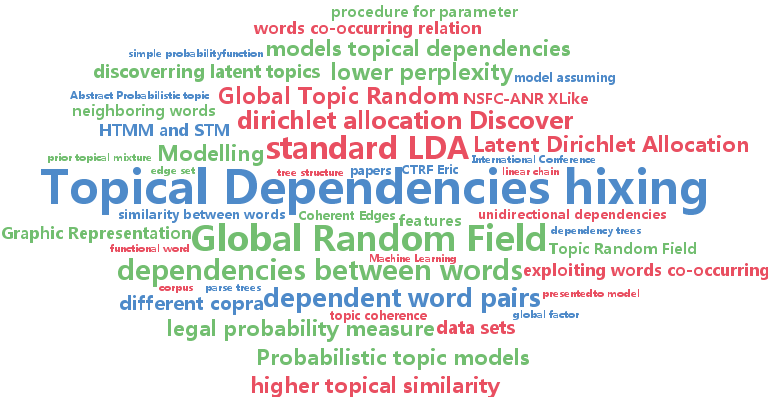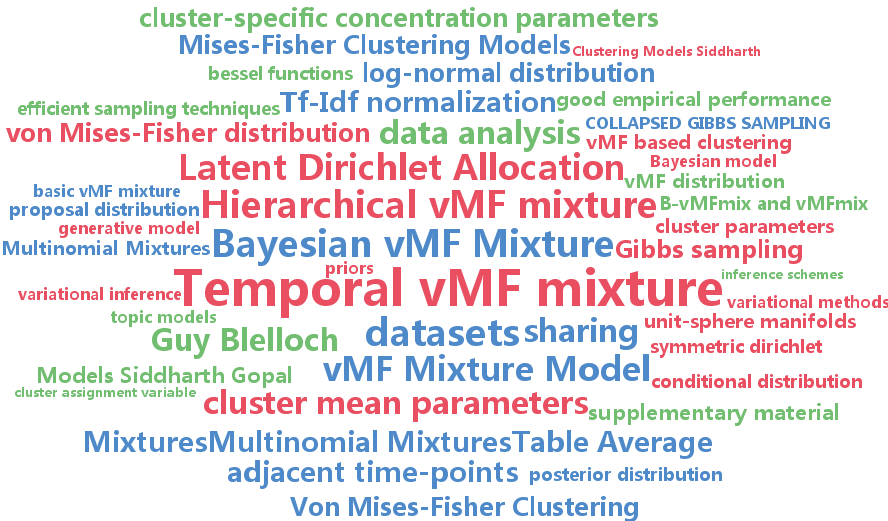latent dirichlet allocation
-
Jason Weston and Ron Weiss and Hector Yee
Affinity Weighted Embedding (pdf)
Supervised linear embedding models like Wsabie (Weston et al., 2011) and supervised semantic indexing (Bai et al., 2010) have proven successful at ranking, recommendation and annotation tasks. However, despite being scalable to large datasets they do not take full advantage of the extra data due to their linear nature, and we believe they typically underfit. We propose a new class of models which aim to provide improved performance while retaining many of the benefits of the existing class of embedding models. Our approach works by reweighting each component of the embedding of features and labels with a potentially nonlinear affinity function. We describe several variants of the family, and show its usefulness on several datasets.
-
Shike Mei and Jun Zhu and Jerry Zhu
Robust RegBayes: Selectively Incorporating First-Order Logic Domain Knowledge into Bayesian Models (pdf)
Much research in Bayesian modeling has been done to elicit a prior distribution that incorporates domain knowledge. We present a novel and more direct approach by imposing First-Order Logic (FOL) rules on the posterior distribution. Our approach unifies FOL and Bayesian modeling under the regularized Bayesian framework. In addition, our approach automatically estimates the uncertainty of FOL rules when they are produced by humans, so that reliable rules are incorporated while unreliable ones are ignored. We apply our approach to latent topic modeling tasks and demonstrate that by combining FOL knowledge and Bayesian modeling, we both improve the task performance and discover more structured latent representations in unsupervised and supervised learning.
-
Sanmay Das and Allen Lavoie
Automated inference of point of view from user interactions in collective intelligence venues (pdf)
Empirical evaluation of trust and manipulation in large-scale collective intelligence processes is challenging. The datasets involved are too large for thorough manual study, and current automated options are limited. We introduce a statistical framework which classifies point of view based on user interactions. The framework works on Web-scale datasets and is applicable to a wide variety of collective intelligence processes. It enables principled study of such issues as manipulation, trustworthiness of information, and potential bias. We demonstrate the model's effectiveness in determining point of view on both synthetic data and a dataset of Wikipedia user interactions. We build a combined model of topics and points-of-view on the entire history of English Wikipedia, and show how it can be used to find potentially biased articles and visualize user interactions at a high level.
-
Zhixing Li and Siqiang Wen and Juanzi Li and Peng Zhang and Jie Tang
On Modelling Non-linear Topical Dependencies (pdf)
Probabilistic topic models such as Latent Dirichlet Allocation (LDA) discover latent topics from large corpora by exploiting words' co-occurring relation. By observing the topical similarity between words, we find that some other relations, such as semantic or syntax relation between words, lead to strong dependence between their topics. In this paper, sentences are represented as dependency trees and a Global Topic Random Field (GTRF) is presented to model the non-linear dependencies between words. To infer our model, a new global factor is defined over all edges and the normalization factor of GRF is proven to be a constant. As a result, no independent assumption is needed when inferring our model. Based on it, we develop an efficient expectation-maximization (EM) procedure for parameter estimation. Experimental results on four data sets show that GTRF achieves much lower perplexity than LDA and linear dependency topic models and produces better topic coherence.
-
Uri Shalit and Gal Chechik
Coordinate-descent for learning orthogonal matrices through Givens rotations (pdf)
Optimizing over the set of orthogonal matrices is a central component in problems like sparse-PCA or tensor decomposition. Unfortunately, such optimization is hard since simple operations on orthogonal matrices easily break orthogonality, and correcting orthogonality usually costs a large amount of computation. Here we propose a framework for optimizing orthogonal matrices, that is the parallel of coordinate-descent in Euclidean spaces. It is based on {\em Givens-rotations
-
Tianlin Shi and Jun Zhu
Online Bayesian Passive-Aggressive Learning (pdf)
Online Passive-Aggressive (PA) learning is an effective framework for performing max-margin online learning. But the deterministic formulation and estimated single large-margin model could limit its capability in discovering descriptive structures underlying complex data. This paper presents online Bayesian Passive-Aggressive (BayesPA) learning, which subsumes the online PA and extends naturally to incorporate latent variables and perform nonparametric Bayesian inference, thus providing great flexibility for explorative analysis. We apply BayesPA to topic modeling and derive efficient online learning algorithms for max-margin topic models. We further develop nonparametric methods to resolve the number of topics. Experimental results on real datasets show that our approaches significantly improve time efficiency while maintaining comparable results with the batch counterparts.
-
Jian Tang and Zhaoshi Meng and Xuanlong Nguyen and Qiaozhu Mei and Ming Zhang
Understanding the Limiting Factors of Topic Modeling via Posterior Contraction Analysis (pdf)
Topic models such as the latent Dirichlet allocation (LDA) have become a standard staple in the modeling toolbox of machine learning. They have been applied to a vast variety of data sets, contexts, and tasks to varying degrees of success. However, to date there is almost no formal theory explicating the LDA's behavior, and despite its familiarity there is very little systematic analysis of and guidance on the properties of the data that affect the inferential performance of the model. This paper seeks to address this gap, by providing a systematic analysis of factors which characterize the LDA's performance. We present theorems elucidating the posterior contraction rates of the topics as the amount of data increases, and a thorough supporting empirical study using synthetic and real data sets, including news and web-based articles and tweet messages. Based on these results we provide practical guidance on how to identify suitable data sets for topic models, and how to specify particular model parameters.
-
Siddharth Gopal and Yiming Yang
Von Mises-Fisher Clustering Models (pdf)
This paper proposes a suite of models for clustering high-dimensional data on a unit sphere based on Von Mises-Fisher (vMF) distribution and for discovering more intuitive clusters than existing approaches. The proposed models include a) A Bayesian formulation of vMF mixture that enables information sharing among clusters, b) a Hierarchical vMF mixture that provides multi-scale shrinkage and tree structured view of the data and c) a Temporal vMF mixture that captures evolution of clusters in temporal data. For posterior inference, we develop fast variational methods as well as collapsed Gibbs sampling techniques for all three models. Our experiments on six datasets provide strong empirical support in favour of vMF based clustering models over other popular tools such as K-means, Multinomial Mixtures and Latent Dirichlet Allocation.







